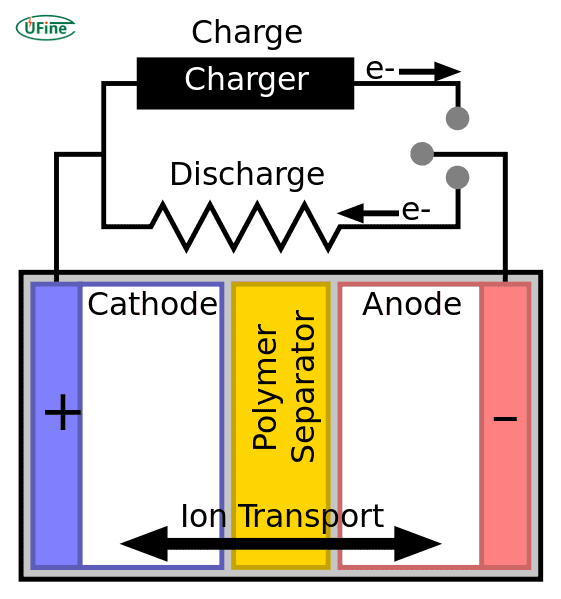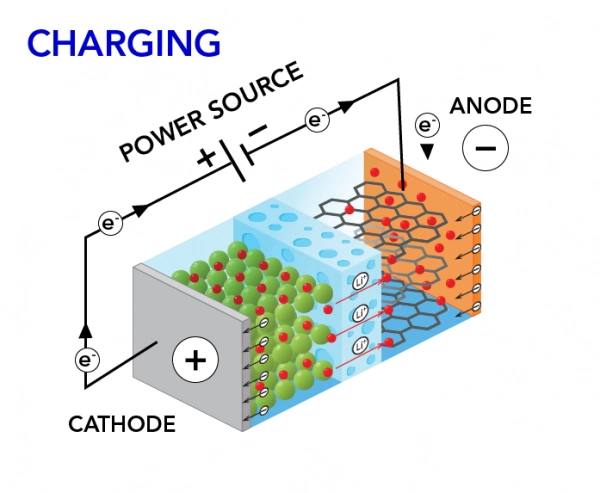Rechargeable batteries have become essential to our daily lives, powering various devices, from smartphones to electric vehicles. However, one common question is, “How long does a rechargeable battery last per charge?” In this comprehensive guide, we will delve into the factors that determine the lifespan of rechargeable batteries and provide insights on maximizing their performance. Whether you’re curious about your smartphone battery or want to optimize the usage of your rechargeable devices, this article will provide you with valuable information.
Part 1. What are rechargeable batteries & Why are they important?
Rechargeable batteries, also known as secondary batteries, are designed to be recharged and reused multiple times. They are more eco-friendly than disposable batteries, as they reduce waste and save money in the long run. Rechargeable batteries are available in various chemistries, including nickel-cadmium (Ni-Cd), nickel-metal hydride (Ni-MH), and lithium-ion (Li-ion). Each chemistry has its characteristics and lifespan.
Part 2. Factors rechargeable battery lifespan
The lifespan of rechargeable batteries per charge can vary significantly depending on several factors such as battery chemistry, usage patterns, temperature, and charging habits. Understanding these factors can help you extend battery life and maximize performance.
- Chemistry: Different battery chemistries have varying lifespans. For example, Ni-Cd batteries typically last 500-1000 charge-discharge cycles, while Ni-MH batteries can handle 300-500 cycles. On the other hand, Li-ion batteries can last for 500-1000 cycles or more, depending on usage and maintenance.
- Usage patterns: The frequency and depth of discharge cycles significantly impact battery lifespan. Shallow discharges (using only a tiny portion of the battery’s capacity) and recharging before complete discharge tend to extend battery life.
- Temperature: Extreme hot and cold temperatures can negatively affect battery performance and lifespan. It’s best to operate rechargeable batteries within the manufacturer’s specified temperature range for optimal results.
- Overcharging and over-discharging: Exposing rechargeable batteries to overcharging or deep discharging can lead to premature failure and reduced lifespan.
Part 3. Lifespan of common rechargeable batteries
Let’s explore the most common types of rechargeable batteries and their typical lifespans:
- Nickel-cadmium (Ni-Cd) batteries: Ni-Cd batteries have been widely used but are less common nowadays due to their lower energy density and environmental concerns. They have a lifespan of 500-1000 charge-discharge cycles.
- Nickel-metal hydride (Ni-MH) batteries: Ni-MH batteries offer higher energy density and are considered more environmentally friendly than Ni-Cd batteries. They have a lifespan of around 300-500 cycles.
- Lithium-ion (Li-ion) batteries: Li-ion batteries have revolutionized the rechargeable battery market. They provide higher energy density, lower self-discharge rates, and longer lifespans than other rechargeable battery types. The lifespan of Li-ion batteries varies depending on usage and maintenance but can typically last for 500-1000 cycles or more.
Part 4. Estimating battery life for different devices
Battery life varies significantly depending on the device and its power requirements. Here are some estimates for popular devices:
- Smartphones: The battery life of smartphones can range from a few hours to a full day, depending on the device’s capacity, usage patterns, and settings.
- Laptops: Laptop battery life varies depending on screen brightness, CPU usage, and capacity. It can range from a couple of hours to several hours.
- Electric Vehicles (EVs): Manufacturers measure EV battery life in range. Modern electric vehicles can typically travel around 200-300 miles (320-480 kilometers) on a single charge. However, this can vary depending on driving conditions and the vehicle’s battery capacity.
- Power Tools: The battery life of power tools depends on the tool’s power requirements and the battery’s capacity. It can range from a few minutes to several hours, with higher-capacity batteries providing longer operating times.
Part 5. How do you charge rechargeable batteries? (with Smart and Fast Charging Tips)
- Choose the Right Charger: Select a charger specifically designed for the type and size of your rechargeable batteries. Using the wrong charger can lead to overcharging or undercharging, damaging the batteries over time.
- Check Battery Compatibility: Before inserting the batteries into the charger, ensure they match its specifications. Mismatched batteries can cause charging issues and potentially damage the charger.
- Insert Batteries Correctly: Pay attention to the polarity markings on the batteries and the charger. Align the positive (+) and negative (-) ends correctly to prevent short circuits and ensure proper charging.
- Connect Charger to Power Source: Once you insert the batteries correctly, plug the charger into a power source. Ensure the power source is stable and reliable to avoid interruptions during the charging process.
- Monitor Charging Progress: Most chargers have indicator lights showing the charging status. Monitor these indicators to know when the batteries are charging and fully charged. Avoid leaving batteries in the charger for extended periods after fully charging to prevent overcharging.
- Unplug Charger After Charging: Unplug the charger from the power source once the batteries reach full charge. Leaving the charger connected to the power source can save energy and avoid a fire hazard.
- Inspect Batteries and Charger Regularly: Periodically check the batteries and charger for any signs of damage or malfunction. Replace any damaged components immediately to prevent accidents and ensure safe charging.
- Smart Charging Technologies: Smart charging systems are becoming increasingly popular for ensuring the optimal charge cycle. These systems adjust the charging speed based on the battery’s condition, helping to prevent overcharging, reduce heat buildup, and extend battery lifespan. Consider using chargers that feature smart charge management technology, which adapts to your battery’s needs.
- Fast Charging: Fast charging technology, available in many modern devices, allows batteries to charge at a much quicker rate without damaging the battery. However, it’s important to note that frequent use of fast charging can increase heat and degrade the battery’s lifespan. For regular use, it’s best to stick to standard charging speeds for longer battery health.
- Wireless Charging: Wireless charging is a convenient way to charge your devices without needing physical cables. However, it’s important to ensure the charger is designed for your device’s battery type to avoid inefficiencies and overheating. While wireless charging can be slower than wired charging, it’s a great option for everyday use when convenience is a priority.
Part 6. How to prolong the rechargeable battery life?
- Avoid Overcharging: Overcharging can lead to heat buildup and reduce the battery’s lifespan. Once the batteries reach full charge, remove them from the charger to prevent overcharging.
- Use the Right Charger: Use a charger compatible with your rechargeable batteries. Using an incompatible charger can lead to improper charging and battery damage.
- Charge at Room Temperature: Charging batteries at extreme temperatures can affect their performance and lifespan. Aim to charge batteries at room temperature to ensure optimal charging conditions.
- Store Batteries Properly: When not in use, store rechargeable batteries in a cool, dry place away from direct sunlight and moisture. Avoid storing batteries in hot environments, as high temperatures can degrade battery performance.
- Avoid Deep Discharges: Avoid fully discharging rechargeable batteries before recharging them. Deep discharges can put additional stress on the batteries and reduce their lifespan. Instead, recharge batteries when they reach a partial discharge.
- Cycle Batteries Regularly: Periodically fully discharge and recharge rechargeable batteries to maintain their capacity and performance. This process, known as cycling, helps prevent the buildup of battery memory and ensures consistent performance over time.
- Replace Old Batteries: Rechargeable batteries will degrade and lose capacity over time. When batteries no longer hold a charge or show decreased performance, it’s time to replace them with new ones.
For more tips on lithium-ion battery care, check out our guide on extending lithium-ion battery life.
Want to prolong the life of your rechargeable batteries? Explore our range of high-quality, long-lasting batteries that offer optimal performance.
Part 7. FAQs
-
How many times can a rechargeable battery be recharged?
Rechargeable batteries can typically be recharged anywhere from 200 to 1000 times or more, depending on the type of battery and usage conditions. For example, users can often recharge NiMH batteries around 500 times. In contrast, lithium-ion batteries can withstand more cycles, usually up to 1000 or more. -
Do rechargeable batteries run out of charge?
Yes, rechargeable batteries will eventually run out of charge after being used. However, you can recharge them multiple times before their capacity significantly diminishes. -
How long can rechargeable batteries sit?
When stored properly, rechargeable batteries can typically retain their charge for several months to a few years. For example, NiMH batteries can keep about 70-80% of their charge after six months of storage, while lithium-ion batteries can retain a higher percentage, around 90%. -
Do batteries last longer when fully charged?
Storing fully charged rechargeable batteries can help maintain their capacity and prolong their lifespan. However, it’s essential only to store them partially charged for extended periods, which can lead to capacity loss over time. -
Do rechargeable batteries get weaker over time?
Rechargeable batteries degrade over time due to usage, charging cycles, and storage conditions. Rechargeable batteries can lose about 20% of capacity after 500 charging cycles. -
Do rechargeable batteries drain when not in use?
Rechargeable batteries may experience self-discharge, losing charge over time even when not in use. The rate of self-discharge varies depending on the battery type and other factors. For example, NiMH batteries typically lose about 1-2% of their charge daily. In contrast, lithium-ion batteries have a lower self-discharge rate, around 5% per month.
Related Tags:
More Articles

How to Choose the Best Floor Scrubber Battery for Commercial Cleaning?
Selecting the ideal floor scrubber battery ensures a long runtime, rapid charging, and minimal maintenance for efficient commercial cleaning operations.
Battery for Blower vs Battery for Leaf Vacuum: Which One Should You Choose?
Battery for blower vs leaf vacuum—learn the key differences in power, fit, and runtime to choose the right battery for your outdoor tool needs.
How to Choose the Right Battery for Blower?
Choosing the right blower battery? Consider voltage, capacity, chemistry & usage. This guide helps match the best battery for peak performance.
How to Choose the Best Insulated Battery Box for Lithium Batteries?
Choosing the Best Insulated Battery Box for Lithium Batteries? Discover key factors such as size, material, and safety for optimal protection and performance.
7 Critical Elements on a Lithium Battery Shipping Label
What must be on a lithium battery shipping label? Learn 7 key elements to ensure safety, legal compliance, and correct handling across all transport modes.





